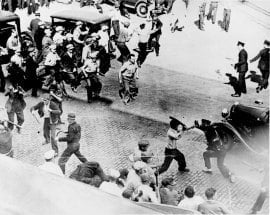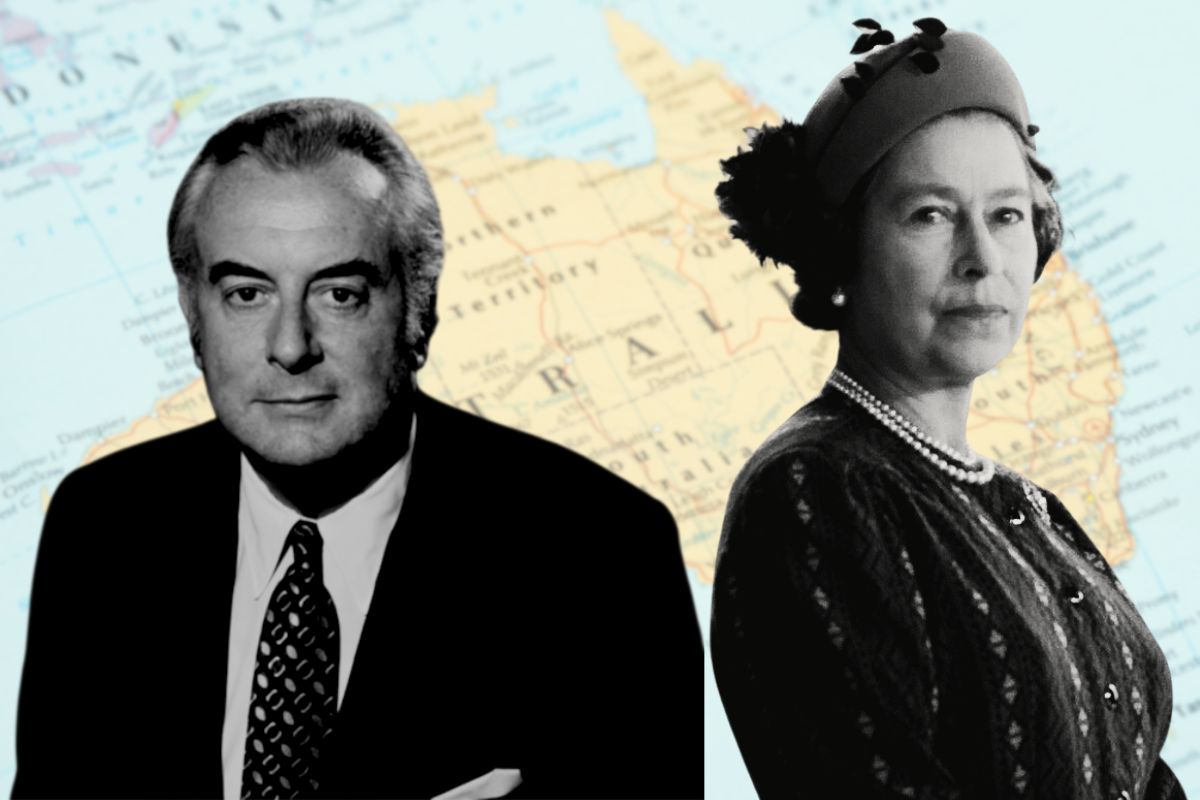Eighty years ago in the US, a branch of the Teamsters union, Local 574 lead a magnificent struggle against ruthless bosses and their backers in government. Critically, the branch had within its ranks a revolutionary leadership able to organise the fight at every stage. Bob Faulkes looks back at a strike that has inspired union militants over the decades.
Eighty years ago in the US, a branch of the Teamsters union, Local 574 lead a magnificent struggle against ruthless bosses and their backers in government. Critically, the branch had within its ranks a revolutionary leadership able to organise the fight at every stage. Bob Faulkes looks back at a strike that has inspired union militants over the decades.
Labour vs Capital
In 1865, the American Civil War finished and with it slavery. However wage slavery remained for the masses, black and white. Within a few years, workers had begun the process of organising into unions. As capitalism grew, the bosses responded to workers’ challenges with the violence of hired thugs and the Pinkerton men. The civil war of Labour vs Capital had begun.
The bosses were able to rely on the state machine to back up their strike breaking and murder – hundreds of workers would die in the following decades. However, Labour fought back. The names of giants of the movement such as Big Bill Haywood and Joe Hill remain etched in the memory of the American working class up to this very day.
However, with the growth of the unions came the growth of a bureaucracy, ready to compromise. The president of the American Federation of Labour (AFL), Samuel Gompers, summed this up when in 1919 he said: “We believe in the effort of employers and employees to sit down around the table and in meeting thus face to face having a better understanding of each other’s position in relation to conditions of labour, to hours, standards etc.”
This approach would become known as ‘business unionism’ or simply Gomperism. From then on the AFL would mainly stick to organising the skilled and public sector workers. The unskilled and semi-skilled workers who made up the bulk of the US workforce would be left alone, thought to as being potential strikebreakers given the conditions they lived under.
Attacks and struggle
Despite Gomperism, industrial struggles continued throughout the 1920s, often in the face of attacks from the police, the National Guard and strikebreaking gangs. However, in 1929 the Great Crash hit the workers like a tornado. Millions were thrown out of work and those in work saw wages frozen or cut as bosses took advantage of the desperate times.
It would take until 1933 before workers felt confident enough to fight back. Strike-breaking brutality was still the order of the day but three events in 1934 would change the balance of forces.
First, the longshoremen in San Francisco fought a successful three-month battle for union recognition, which eventually turned into a West Coast general strike.
In Toledo, the Auto-Lite strike showed workers standing firm against every trick of the bosses. The state attempted to rule the action illegal, the troops were sent in and 10,000 workers and unemployed came out to meet them. For six days the battle raged on: guns and ammo verses sticks and stones. Efforts were even made to try and win the troops over on a class basis, an appeal which had some effect with some of the National Guardsmen just turning and going home. Workers were killed but still the forces of labour stood firm with 40,000 attending a rally. Local union branches voted to call a general strike. Finally, the bosses caved in and a major victory was won.
The Teamster Union
Meanwhile as spring turned to summer in 1934, another mighty struggle was unfolding in Minneapolis where the Teamster Union in the form of Local (branch) 574 was mounting a stand of its own.
For a number of years, Minneapolis had been dominated by the ‘Citizens Alliance,’ a cabal of bosses determined that they would have an ‘open town’ with no union presence. However, in the leadership of Local 574 was a layer of ex-communist party militants who had been expelled from the party for supporting Leon Trotsky. These were tried-and-tested veterans of union struggles determined to build the union. During 1934, three strikes lead by Local 574 would shatter the power of the bosses cabal and show a generation of militants how to fight and win.
The leadership of local 574 would bring a raft of bold new methods to the struggle. Cruising picket cars would be used to monitor the movement of scab trucks, becoming the eyes and ears of the strike forces. The union would produce its own newspaper, The North-West Organiser, to counteract the lies of the bosses’ press. The union also organised a women’s group to provide much needed support and solidarity. Crucially, Local 574 would mobilise the forces of the unemployed by identifying the need to fight for better benefits.
Local 574 acted as a ‘general’ union, ignoring the elitism of Gomperism by being open to all. When the police charged strikers, they had the forces to stand firm and beat the attacks back. With a militant leadership, the membership of Local 574 quickly grew.
The first strike was in the coal yards where the determination of the workers came as something of a surprise to the complacent bosses who were soon forced to recognise the union. This victory would earn Local 574 the hatred both of the Citizen’s Alliance and of the union’s national leadership who preferred compromise. Next on the agenda was the key question of the trucking industry in Minneapolis.
Taking on the bosses
During the spring of 1934, a concerted campaign by the bosses against the “red threat” of the growing union power in Minneapolis was undertaken. The union also organised meetings as a citywide strike of truckers loomed. Demands were presented and when they were rejected it was clear what was coming next. The Citizens Alliance warned its members on May 11th that a strike was coming and on May 12th at a mass meeting the vote was taken by the workers to stop working on May 16th.
Using the methods described above, Local 574 was able to take on the bosses in a way that had not been seen before. The Citizens Alliance attempted to organise scab armies to break the strike by force. One such conflict would become known (in Civil War style) as ‘the Battle of the Deputies Run’ as a scab force, legalised by the state as ‘deputies’, was beaten back by strikers despite being very well-armed beforehand. Footage of the battles between the workers and the police were screened in cinemas around the country with each victory for the union being loudly cheered.
Finally, the pressure told on the employers and negotiations were hurriedly organised. After three hard days of talking the strike was suspended, with the union winning recognition and improvements in pay and conditions.
Fighting leadership
Naturally, the employers soon began to renege on the agreement and a new strike was set for July 20th. Again, Local 574 planned things on a military scale. The union national leadership was desperate for a settlement but Local 574 stood firm against such pressure from above.
The July strike would not be without its costs however. On July 20th, police opened fire on picket trucks without reason and two strikers were killed. Instead of breaking the will of the strikers, this violence just re-enforced it. Battles between police and pickets continued and the state governor, Floyd Olson, declared martial law. Union leaders were arrested as the National Guard arrived to bolster the forces of reaction, but the strike went on.
After a month of striking the employers, under pressure from above, called for a settlement. The union re-affirmed its right to represent workers and the “open town” claim lay in tatters – Minneapolis was now a union town. A fighting leadership, steeled by Marxism, linked to a tenacious membership, had broken the bosses.
The employers were angry but could do nothing; the union national leadership was even angrier but would spend the next few years trying to break the union from above. They would both be aided by President Roosevelt, who has often been portrayed by Stalinists in the trade unions as “a friend” but in reality used his position to undermine union militancy by the use of the FBI, the courts and vicious anti-union laws.
The Minneapolis teamsters would go on to mount an ambitious unionisation drive across the whole of the state and this was picked up and expanded elsewhere, increasing Teamster membership from the figure of 80,000 at the start of the decade up to 500,000 by the end. The mood to unionise the unskilled workers would lead to the founding of the Congress of Industrial Organisation (CIO) to deal with those sectors still being ignored by the AFL.
Revolutionary inspiration
The example of the Minneapolis workers alongside that of the San Francisco Longshoremen and the Toledo strikers would inspire other sections around the country to take action and stand up to the employers over the next few years. Huge battles would unfold culminating in the action of the General motors workers in Michigan.
Today, we are facing similar conditions with the bosses seeking to solve the crisis at our expense. The lessons of Local 574 will need to be taken on board by today’s union militants.
Crucial is the understanding that the politics of the Minneapolis leadership was central to the victory of the union in 1934 and that workers today also need to arm themselves with the ideas and methods of Marxism as new battles unfold. The Marxists in the leadership of the Minneapolis Teamsters understood that industrial action alone could not solve the plight of the American workers, a political solution was needed – one based on socialism. To that end they also understood the need to take Trotsky’s advice and recruit the best of the union activists into the ranks of the revolutionary tendency, and to arm them with a political and theoretical understanding of the class nature of capitalist society and the need to overthrow it with socialist policies.






